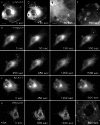Stimulation of primary osteoblasts with ATP induces transient vinculin clustering at sites of high intracellular traction force
- PMID: 23933795
- PMCID: PMC4544565
- DOI: 10.1007/s10735-013-9530-7
Stimulation of primary osteoblasts with ATP induces transient vinculin clustering at sites of high intracellular traction force
Abstract
Adenosine 5'-triphosphate (ATP), released in response to mechanical and inflammatory stimuli, induces the dynamic and asynchronous protrusion and subsequent retraction of local membrane structures in osteoblasts. The molecular mechanisms involved in the ligand-stimulated herniation of the plasma membrane are largely unknown, which prompted us to investigate whether the focal-adhesion protein vinculin is engaged in the cytoskeletal alterations that underlie the ATP-induced membrane blebbing. Using time-lapse fluorescence microscopy of primary bovine osteoblast-like cells expressing green fluorescent protein-tagged vinculin, we found that stimulation of cells with 100 μM ATP resulted in the transient and rapid clustering of recombinant vinculin in the cell periphery, starting approximately 100 s after addition of the nucleotide. The ephemeral nature of the vinculin clusters was made evident by the brevity of their mean assembly and disassembly times (66.7 ± 13.3 s and 99.0 ± 6.6 s, respectively). Traction force vector maps demonstrated that the vinculin-rich clusters were localized predominantly at sites of high traction force. Intracellular calcium measurements showed that the ligand-induced increase in [Ca(2+)]i clearly preceded the clustering of vinculin, since [Ca(2+)]i levels returned to normal within 30 s of exposure to ATP, indicating that intracellular calcium transients trigger a cascade of signalling events that ultimately result in the incorporation of vinculin into membrane-associated focal aggregates.
Figures




References
MeSH terms
Substances
LinkOut - more resources
Full Text Sources
Other Literature Sources
Miscellaneous

